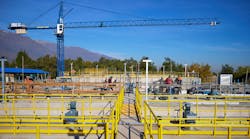The number of people in Japan with access to wastewater treatment facilities increased by about 2.5 million, to 98.5 million, between the end of fiscal year (FY) 2002 and the close of FY 2003 on March 31, 2004, according to a new Japanese Ministry of the Environment report.
With this change, nearly 78% of the Japanese population now has access to such facilities, compared to nearly 76% at the close of FY 2002, a ministry press statement noted.
However, while most residents in large cities have access to some form of wastewater treatment, only slightly more than half (56%) of residents in towns with populations less than 50,000 have such access, the statement said.
Overall, about 85 million Japanese residents are served by full-fledged sewerage systems, about 3 million have access only to "agricultural effluent treatment facilities," and about 380,000 have access to community wastewater treatment plants, according to the press statement. An additional 10 million people use facilities called johkasoh, onsite systems that treat domestic wastewater and discharge the treated effluent to a nearby waterway, the statement said.
Johkasoh typically have the same treatment capability as a treatment facility in a conventional wastewater system, with a removal rate (treatment to less than 20 mg/L) of about 90% for biochemical oxygen demand, according to the statement.
Because johkasoh generally are more efficient and cost-effective than conventional wastewater treatment systems, the Environment Ministry since 1987 has subsidized their installation and use for residents and municipalities willing to use them, the press statement noted.
The number of municipalities taking advantage of the subsidy program rose from 175 in January 2003 to 217 by April 2004, the statement said. At the end of FY 2003, 10.3 million Japanese residents were using johkasoh, about 8% more than in the previous year, according to the statement. For more information, send e-mail to the Japanese Environment Ministry at [email protected].
Source: WEF

